
For the 21 responses to it, Click here.
For the latest updated version, Click here.
1. Summary
This draft document presents an audit of the performance of Wirral Council in protecting pedestrians as at November 2015. It is being circulated to the appropriate people so that errors, omissions and judgements can be corrected. All comments are welcome, to contact[at]pedestriansafety.org.uk. The standards used are
- Relevant human rights, statutory requirements and Wirral Council's Constitution
- Additional Council commitments e.g. in Wirral Council's Plan: A 2020 Vision
- Best practice elsewhere.
| Aspect | Rating | Basis for rating | |
|---|---|---|---|
| Overall Performance |  Very poor Very poor |
| |
| Pedestrian casualties and road danger |  Poor Poor |
| |
| Reporting of pedestrian casualties |  Very poor Very poor |
| |
| Pedestrian Safety Plan |  Very poor Very poor |
| |
| Speed limits and compliance |  Poor Poor |
| |
| Illegal parking |  Very poor Very poor |
| |
| 'A' boards and other pavement hazards |  Very poor Very poor |
|
Conclusions: Wirral Council is performing poorly or very poorly in aspects of pedestrian safety compared to legal requirements, commitments given, and best practice; and vulnerable people are suffering as a consequence. Major changes are needed.
Individuals Responsible for Pedestrian Safety within Wirral Council
- Councillors: Phil Davies (Council Leader) and Stuart Whittingham (Cabinet Member)
- Officers: Eric Robinson (Chief Executive), Kevin Adderley (Strategic Director for Regeneration and Environment)(until autumn 2015), Mark Smith (Head of Environment and Regulation), and Dr Fiona Johnstone (Director of Public Health).
Audit written by: Ian Campbell MD with assistance from colleagues in a number of voluntary groups.
2. Standards used in judging Wirral Council
The performance of Wirral Council is judged against the following standards.Protection of human rights
The United Nations agreed the Universal Declaration of Human Rights [1] in 1948 and declared that people have a right to life (Article 3), and a right to freedom of movement (Article 13). Consequently, people have a right to travel safely on foot. Also (via Article 8) people have a right to effective legal remedies if this right is not respected.There are similar articles in the European Convention on Human Rights [2].
Statutory requirements
The statutory responsibilities of a Highway Authority for road safetyUnder the 1988 Road Traffic Act, local authorities have a statutory responsibility for road safety. Section 39 of the Act [3] includes the following requirements of local authorities :
Equality legislation
The Equality Act (2010) places a duty on public authorities to promote equality of opportunity and not discriminate on grounds of sex, age, and disability [4]. The Equality Act has been used to challenge failures to provide tactile paving, so it does apply to the street environment . Local authorities have an obligation to carry out Equality Impact Assessments on all policies [5].
Wirral Council's Constitution
The Council's Constitution [6] states six principles of decision making (Section 13.2), including(d) a presumption in favour of openness;
(e) clarity of aims and desired outcomes;
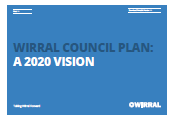
Wirral Council's commitments
Wirral Council has made some additional commitments in its Wirral Council Plan: A 2020 Vision [7] of June 2015, together with the Delivery Plan Phase 1 [8] of October 2015.The Wirral Council Plan contains some pledges:
...OUR PRIORITIES:
Wirral is a place where the vulnerable are safe and protected, every child gets a good start in life and older residents are respected and valued.
Ensuring the most vulnerable among us are safe, and feel safe, is perhaps our most important responsibility. We will work across Council and agency boundaries to promptly identify and tackle problems before they develop. [page 6]
...We will support older people to live independently in their homes and help prevent social isolation. [page 8]
...Ensure that Wirral has safe, affordable, well maintained and efficient transport networks for residents to access community services, enjoy our leisure facilities and commute to work. [page 20]
...We want all of our residents to have a good quality of life and live healthy lifestyles in clean and safe environments. [page 23]
...We remain committed to addressing health inequalities in Wirral through encouraging residents to lead healthier lifestyles, and promoting physical activity and healthy eating. [page 26]
...Our aim is quite simply to be the best Council in the country [their emphasis, page 34]
A separate commitment was given via Wirral Council's membership of the Merseyside Integrated Transport Authority (joined with the other four Merseyside councils). This Authority agreed its Third Local Transport Plan [9] in 2011 with the following vision of making sustainable transport the option of choice:
Best practice elsewhere
Wirral Council's policies and practice in protecting pedestrians should be- as good as that of other local authorities in protecting pedestrians
- as good as policies and practice protecting people using other modes of travel e.g. via rail, air, and motor vehicles
- as professional an approach as that by health professionals treating road casualties
- as thorough in protecting children from motor vehicles as in protecting children from sexual or parental abuse.
If there are any impediment (e.g. budget constraints) that prevents Wirral Council giving a first rate service to pedestrians, the Council should clearly state this so that it can be rectified.
The rating scale used to judge Wirral Council
The following rating scale was used.  | Excellent | Exceeding current best practice in protecting pedestrians e.g. via innovative schemes |
 | Good | Meeting current best practice in protecting pedestrians |
 | Disappointing | Some minor deficiency or deficiencies that should to be corrected, but not likely to lead to harm to pedestrians |
 | Poor | Significant deficiency or deficiencies likely to lead to harm to pedestrians |
 | Very poor | Major deficiency or deficiencies appreciably worse than 'Poor' |
3. Wirral Pedestrian Casualties:  Poor
Poor
Summary
Wirral Council's rate of serious pedestrian casualties is poor and not improving.Wirral Council's rate is in the bottom third of highway authorities
Wirral Council is in the bottom third of highway authorities (ranked 141 out of 206) for reported killed or seriously injured (KSI) pedestrians per 100,000 population in 2010-14 [10]. The total in the five-year period was 161 pedestrians reported as killed or seriously injured.For children, the rate is in the bottom fifth of highway authorities
For child pedestrians reported as killed or seriously injured per 100,000 children in 2010-14, Wirral Council is in the bottom fifth of highway authorities (ranked 174 out of 206) [10]. The total of 59 children was 49% above the national average, and there were 63 local authorities that had rates of less than half that of Wirral Council. ('Children' refers to the age range of 0 - 15 years.)These figures are not improving
There are no signs of a reduction in these figures, as shown by the two charts [11].| Pedestrians | Child pedestrians |
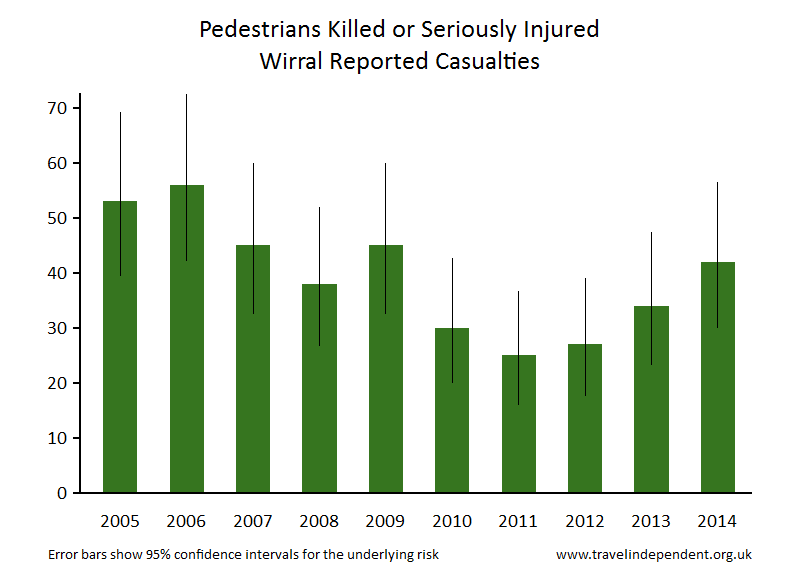 | 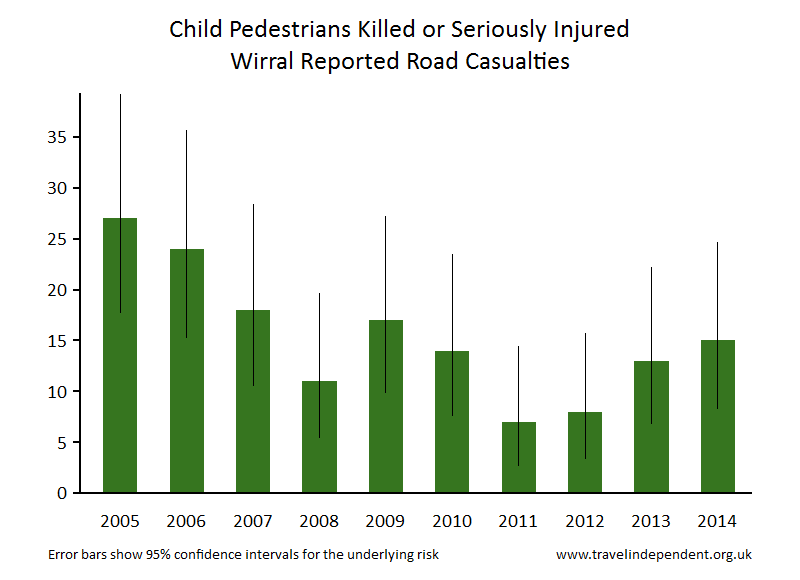 |
Wirral has a history of poor pedestrian casualty figures
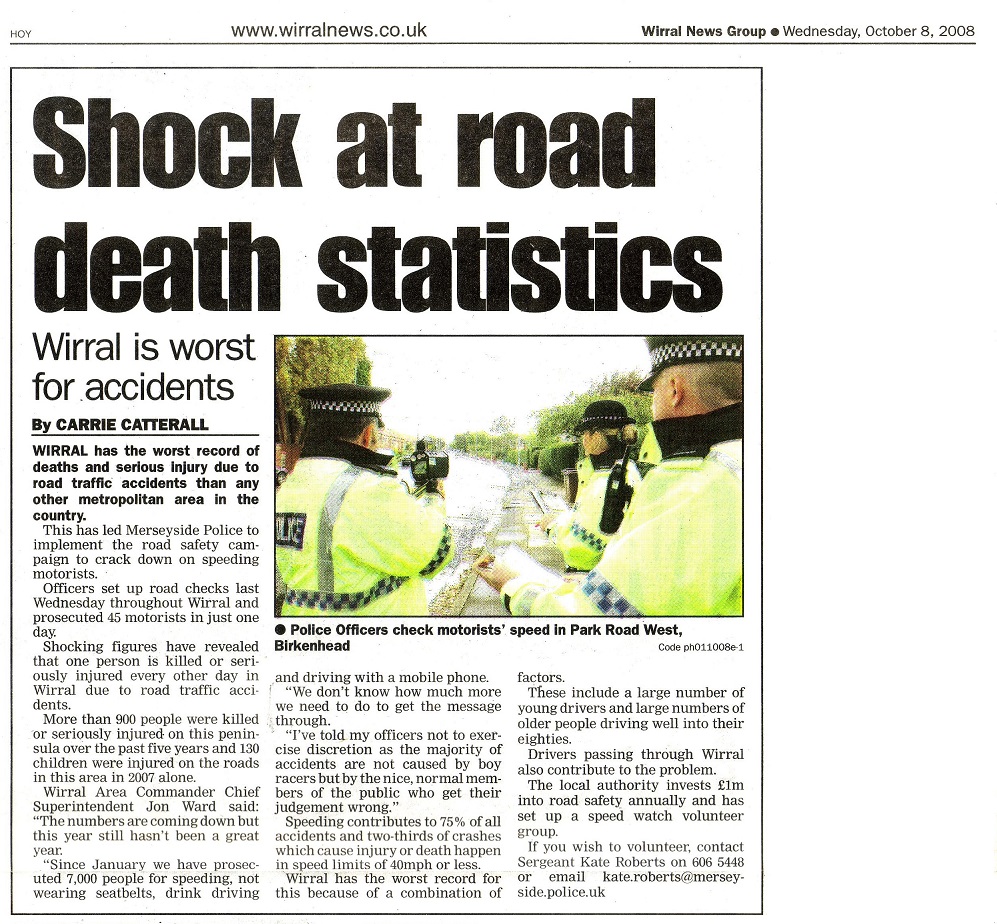 In 2008, the Wirral Globe reported that Wirral had the worst record of deaths and serious injury due to road traffic collisions of any metropolitan area in the country [13].
In 2008, the Wirral Globe reported that Wirral had the worst record of deaths and serious injury due to road traffic collisions of any metropolitan area in the country [13].Poor child cyclist KSI rate
It is also relevant that Wirral Council has a child cyclist KSI rate that is double the national average - the Wirral total of 17 seriously injured children in the 5 years of 2010-14 is a rate of 28.6 per 100,000 children, which is double the national average rate of 14.4 per 100,000 children.4. Reporting of Pedestrian Casualties:  Very poor
Very poor
Summary
Wirral Council has a record of overemphasizing its progress in reducing child pedestrian casualties. The best practice is to give an honest assessment of the casualty situation; for example, Birmingham City Council in its draft Road Safety Strategy [14] drew attention to its high rate of child KSI casualties per head of population in certain areas.It is poor that Wirral Council has a bad child pedestrian serious casualty rate, and that it has given misleading statements about the situation. It is very poor that the misleading statements have continued despite Ofsted criticism. If officers and councillors do not acknowledge that they have a problem with child pedestrian casualties, they are very unlikely to devise the best policies to deal with it.

Ofsted Criticism 2008
An Ofsted report of 2008 [15] criticized Wirral Council in its performance assessment under the heading of "Staying Safe":Misleading Officer Report 2010
Instances of misleading reporting of pedestrian casualties have continued despite the Ofsted criticism. In 2010, officers gave a report to the Sustainable Communities Overview and Scrutiny Committee [16] and stated (para 4.9, referring to the 2009 figures) thatMisleading Cabinet Member Statement to Council 2015
Cllr Stuart Whittingham, at the Wirral Council meeting of 6 July 2015 [17] gave an update on Wirral's highways including the statement that Wirral:- the continuing poor record for child pedestrian casualties on the Wirral
- the similarly poor record for child cyclist casualties on the Wirral
- the large number of unsafe crossing points awaiting infrastructure improvement, such as children having to run across a road as the only safe way to cross it [18]. Residents reporting a dangerous crossing or route to the Council are routinely told that nothing will be done because nobody has been injured there, and that action will be taken only when three people have been injured.
- what plans he has to improve the situation.
Unsubstantiated claims for credit for casualty reductions
There are numerous instances of officers claiming credit for falls in Wirral casualties. It is true that Wirral casualty numbers have fallen for most modes of travel compared with 20 years ago. Whilst all of the falls may be due to officers' actions, it is also possible (or likely) that at least some of the fall is due to other factors such as safer car design, or the documented decline in children and adults walking. So claiming credit for all of the fall in reported casualties may lead to complacency and to other effective interventions being overlooked.5. Overall Pedestrian Safety Plan:  Very poor
Very poor
Summary
Section 3 presented the evidence that if nothing is done, 160 Wirral pedestrians will be seriously injured or killed in the next 5 years. Wirral Council has no stated ambition and no comprehensive plan to prevent these casualties.The problem
Wirral Council's rate of serious pedestrian casualties is poor and not improving (Section 3). Based, on the number of casualties in the last 5 years [11], the following can be anticipated in the coming 5 years.- 1 child pedestrian to be killed and 60 to be seriously injured
- 10 adult pedestrians to be killed and 90 to be seriously injured
- larger numbers of less severe casualties
- many pedestrian journeys not undertaken due to fear of injury, leading to health problems from inactivity.
The best local authorities have pedestrian casualty rates less than half that of the Wirral, so there is an excess of 80 serious injuries or deaths that can potentially be easily prevented. Wirral has many routes that are unsafe for pedestrians such as roads with no footway, footways blocked by parked cars, and unsafe crossing points.
Best practice: a comprehensive road safety plan
The best councils are taking the following steps- declaring that deaths and severe injuries to pedestrians from motor vehicles are unacceptable
- recognising that most people are in support of safer streets for walking and cycling
- adopting a Safe System (Vision Zero) approach [19] to preventing deaths and serious injuries
- setting a target for reduction in pedestrian KSI casualties
- drawing up a comprehensive action plan to achieve this reduction either as a stand-alone plan or as part of a multi-mode action plan.
The elements of these pedestrian safety plans include
- a reduction in the speed and numbers of motor vehicles on the roads
- safer pedestrian routes and crossing points
- better compliance of motor vehicle drivers with road safety laws.
Examples are Bristol [20], Birmingham [14], and London [21].
Wirral Council: a failure to plan
Despite its poor figures, Wirral Council currently has no comprehensive plan to make roads safer for pedestrians and reduce pedestrian KSI casualties. There is a commitment in the Council's 2020 Vision Delivery Plan Phase 1 [8] thatDevelop a new Road Safety Strategy, based on detailed insight.
There is no comprehensive plan to introduce 20mph speed limits in residential, retail and learning locations (see next section). The Council has merely allocated small sums of money to Constituency Committees (area committees) for minor projects, without providing any estimate of the overall effectiveness of this policy.
Merseyside Transport Partnership's sham 'Action plan'
Wirral Council is part of the Merseyside Transport Partnership (with the other Merseyside councils). The Partnership's Annual Progress Report for 2013/14 [22] states that- Cyclists
- Adult pedestrians
- Senior road users
- Motor cyclists
It is very poor that the Partnership claims to have produced an action plan to tackle pedestrian casualties when it has not.
6. Lower Speed Limits and Better Compliance:  Poor
Poor
Summary
Wirral Council has no comprehensive plan to reduce speed limits or improve compliance with speed limits; its plans are limited to some small scale 20mph areas.The current situation
- Most residential streets, retail streets, and streets around schools and colleges still have a speed limit of 30mph or more.
- There is poor compliance with speed limits, as shown by observations around the Council's vehicle-activated speed signs - most drivers can be seen to be exceeding the speed limit.
- Many residents have complained to councillors or signed petitions for lower speeds, e.g. a petition signed by 250 residents asked for a lower speed limit on Mill Hill Road in Irby (Wirral Globe report of 17 July 2013).
Best practice
It is now widely accepted that best practice is to consider introducing wide-area 20mph speed limits on all residential streets, retail streets, and streets around schools and colleges. For example, the National Institute for Health and Care Excellence has recommended [24] that local authorities "introduce engineering measures to reduce speed as part of a broad strategy to prevent injuries and the risk of injuries" including 20 mph limits and zones on appropriate roads.The North West Public Health Observatory has estimated that such a scheme would save five children each year from being seriously injured or killed [25].
Many local authorities have introduced or are currently introducing 20mph speed limits on the majority of their streets. Examples include Portsmouth, Oxford, Liverpool, Bristol, and many London boroughs.
Wirral Policy
Wirral Council did pass a plan in 2012 for wide area 20mph speed limits, with £1.1million of funding allocated over 3 years, but this was cancelled in 2013 .Wirral Council's policy on where 20mph speed limits can be introduced was explained by Mark Smith at the December 2014 Wirral Council Joint Pedestrian/Cycling Forum. As it appeared to differ substantially from the latest Department for Transport's guidelines , Mark Smith was asked to circulate the Council's policy in writing, in order to assist volunteers campaigning for safer roads. He agreed to respond, but he has so far (as at November 2015) failed to do so.
7. Illegal Parking:  Very poor
Very poor
Summary
Vulnerable people have had distressing experiences and have been asking for illegal parking especially pavement parking to be tackled for over 7 years. Wirral Council's response has been evasion and prevarication, in breach of its statutory responsibility. Effectively, the pleas for assistance from the most vulnerable of road users are being met by a refusal to help.Vulnerable people affected: four groups with case histories
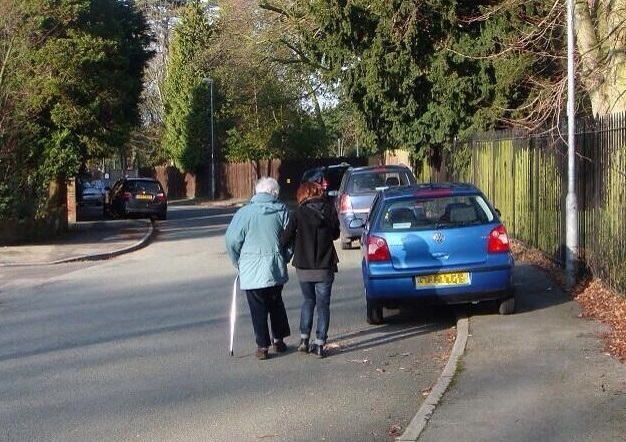
- People using walking aids: Mr A (of West Kirby) complained "we are being robbed of our pavements" at the October 2008 West Wirral Area Forum. Mr A, a retired head teacher spoke about how he tries to walk daily with his elderly wife who needs a three-wheeler walking aid, but due to an increase of pavement parking (at sites where there was no justification) they were frequently forced into the carriageway to get around parked cars. This was obviously distressing for them.
- People using mobility scooters: Mr B, a Newton resident, used to travel to his local shops using his mobility scooter, but was forced to stop once pavement parking blocked his route - he did not have the confidence to go in the carriageway. So he became confined to his house for the last two years of his life except when his son visited him.

- Guide dog owners: Mr C who attended Wirral Council's Pedestrian Forum walks with a guide dog. Pavement parking has worsened to the extent that he can be forced into the carriageway four times in a single trip.
- Other people registered blind: Mr D, a resident of Rock Ferry, has experienced many situations where he has had to step on to a busy road nearly getting knocked down in order to continue with his journey because a vehicle was parked on the pavement. He fears for his life and that of other visually impaired Wirral residents.
The Guide Dogs website now has over 1000 photos on its website showing their concern at the problem of pavement parking - several of these are on the Wirral including the one lower right.
Education: Wirral Council's failure to give clear guidance
Website guidance- The best practice is for the highway authority to give clear guidance on its website in line with the statutory responsibility e.g. Bristol City Council's website contains the following clear information that footway parking is illegal [26].

- Wirral Council has effectively refused to make a similar clear statement on its website. Requests for a clear statement have been made by Wirral Pedestrians Association for several years. Officers did agree in 2014 that a statement would be posted but this has not yet been done despite reminders (as at November 2015).
Furthermore, Mark Smith, Kevin Adderley and Eric Robinson have all refused to make clear statements on the legality of parking such as the Wirral Council vehicle parked completely on a pavement:
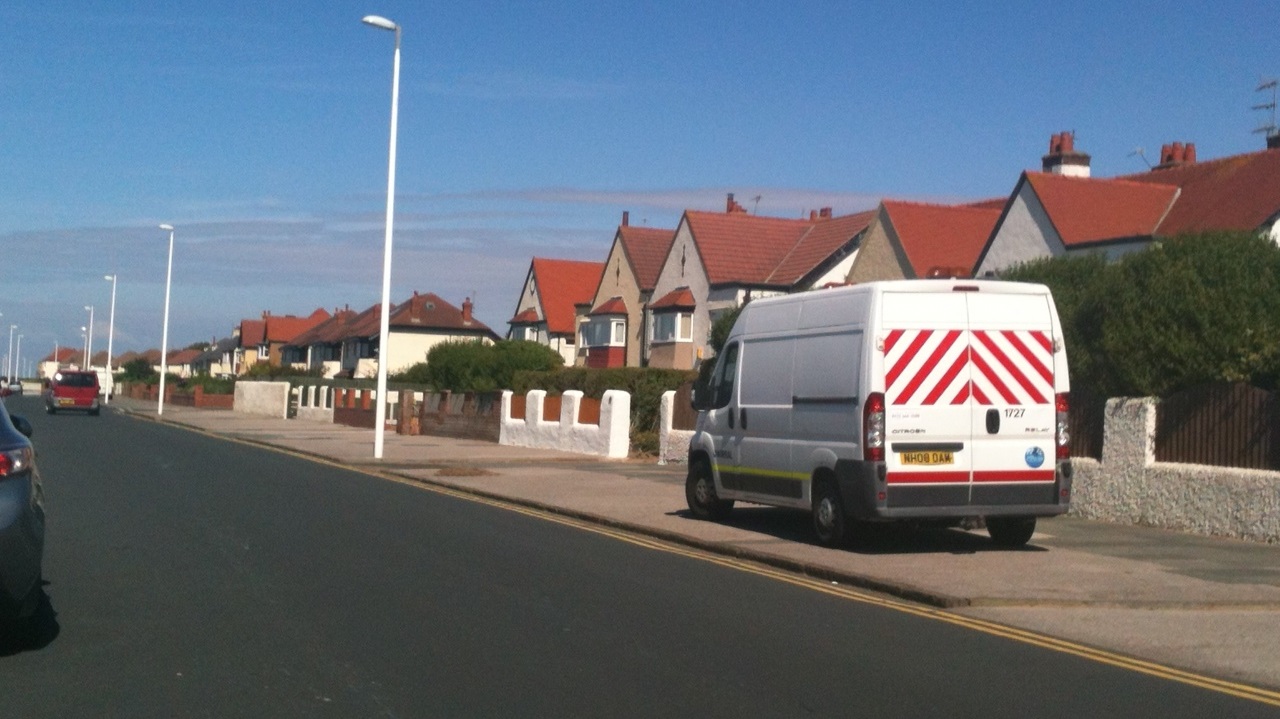
Flyers, posters, stickers and letters
- Best practice: Many councils and police forces distribute publicity concerning the problems that can be caused by pavement parking. Oxford County Council has distributed windscreen stickers that can be used by members of the public.
- Wirral Council deserves some credit for producing some windscreen flyers, but less than 100 have been used, and there is currently no publicity on their availability or how they could be requested. Officers gave a commitment in 2014 to write to companies whose vehicles have been parked illegally, but this commitment has not been met. Cllr Whittingham has made a similar commitment and again this commitment has not been met.
Infrastructure: Best practice and Wirral policy
- Best practice: There are some streets where there is a consensus that pavement parking should be permitted. On such streets, best practice is to mark permitted bays with white lines painted on the pavement e.g. as has been done in Oxford and Liverpool .
- Wirral Council has merely designated a very small number of streets as streets where the ban on pavement parking is enforceable by Council officers or contractors.
Lack of coordination with Merseyside Police
After 7 years of vulnerable people asking for help with pavements blocked by parked vehicles, there is still no co-ordination between Merseyside Police and Wirral Council - see quotes:1. Jane Kennedy, Merseyside Police & Crime Commissioner (her email of 23 June 2014):
Parking on pavements is causing a lot of problems for vulnerable pedestrians. When they ask for help, people in positions of authority should ensure they get it.
Wirral Council setting a poor example
Despite many complaints to senior officers, Council vehicles are still being parked on pavements (as above) . Also there are several credible reports of councillors parking on pavements.8. 'A' boards and other pavement hazards:  Very poor
Very poor
Summary
The pleas of visually impaired and other vulnerable people are being met with a refusal by Wirral Council officers to take action.How vulnerable people are affected
Visually impaired people: The following excerpt is from an October 2013 letter to Wirral Council from an elderly Wirral resident with severe visual impairment.People with restricted mobility also find 'A' boards and shop displays a hazard, especially those in wheelchairs
Poor publicity of Wirral Council's policy
Prior to November 2014, Wirral Council's policy was clearly explained via a web page with downloadable guidance [27]. This policy had been agreed in 2011 via an extensive consultation process. It included detailed guidance concerning dimensions and positioning, including that- 'A' boards and shop displays must be positioned next to the business premises,
- the minimum clear footway width remaining must not be less than 2.0 metres, and
- businesses must apply to Wirral Council for a licence.
The policy was modified in November 2014 by Cllr Stuart Whittingham (the Cabinet Member) accepting the recommendation from an officers' report [28]. This report recommended the removal of the need for licensing, but there was no change to the guidance concerning dimensions and positioning, and Mark Smith confirmed at the December 2014 Pedestrian/Cycling Joint Forum (Item 2) that there were no changes in the criteria [29]
Directional 'A' boards will not be permitted away from the premises.
It is now very difficult for any business or anyone concerned about threats to vulnerable people to establish what criteria form the Council's policy.
Invalid Equality Impact Assessment
An Equality Impact Assessment [31] was carried out as part of the November 2014 Report proposing the change to the 'A' boards and shop display policy. The Assessment was invalid. The procedure should have looked at the impact of the proposed change in policy (the removal of the requirement to apply for a licence), but in the completed Assessment, under the question of which groups might be affected and how (Section 4), it was stated that the impact on Disability groups will beThis raises the question of which other Equality Impact Assessments performed by Wirral Council have not been carried out properly.
Officers ignore the Council's policy when inspecting streets
It is clear from the responses of Wirral Council officers that they take little notice of the Council's policy when inspecting 'A' boards and shop displays. Three examples follow.1. Response from a Senior Enforcement Officer
In reply to a request for clarification of the criteria used, Rob Cain (a Wirral Council Senior Enforcement Officer) wrote (his email of 29 Jan 2014)
Details of the Councils current approach to a-board permissions are on the Council website at http://www.wirral.gov.uk/my-services/business/licensing
2. Shop display in Moreton
A Moreton resident has repeatedly reported a shop in Moreton to Wirral Council for breaching the Council's guidance, including leaving just a narrow gap of 1 metre (forcing pedestrians into the carriageway), and extending across the frontages of neighbouring premises - see photos.
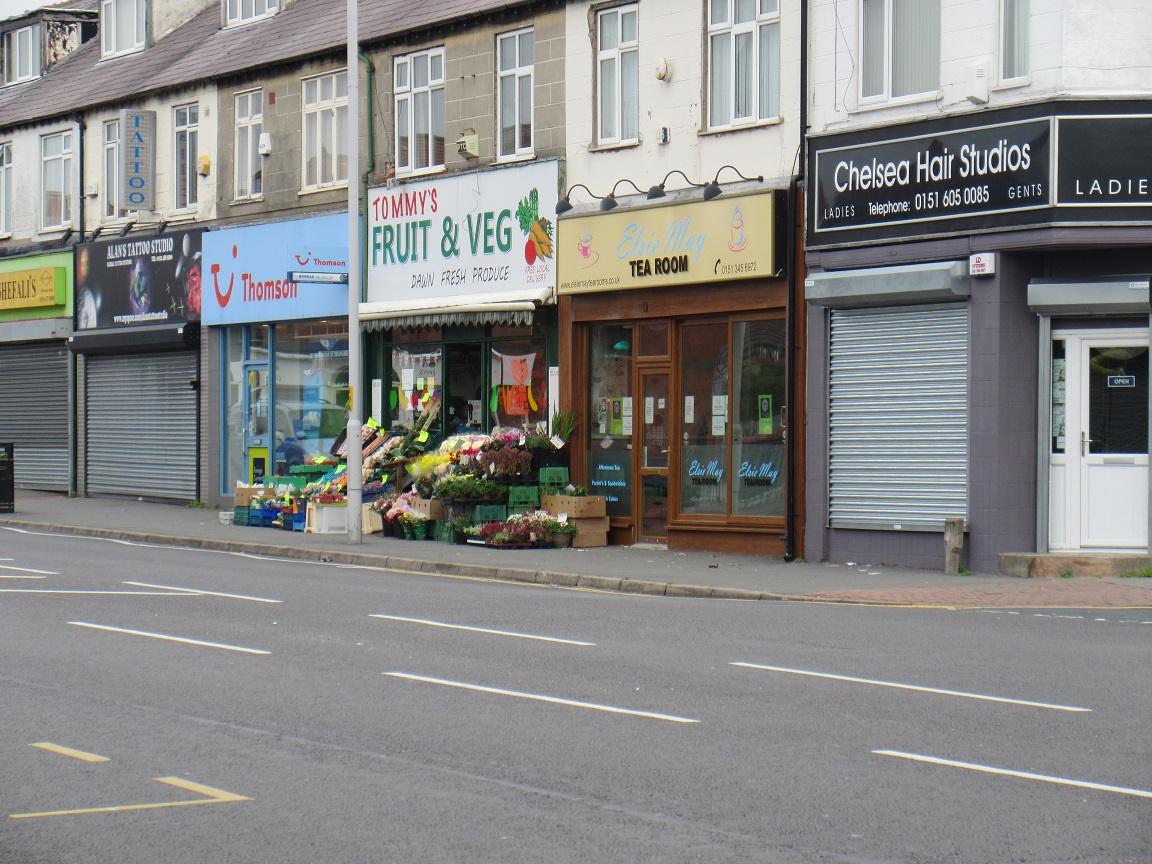 | 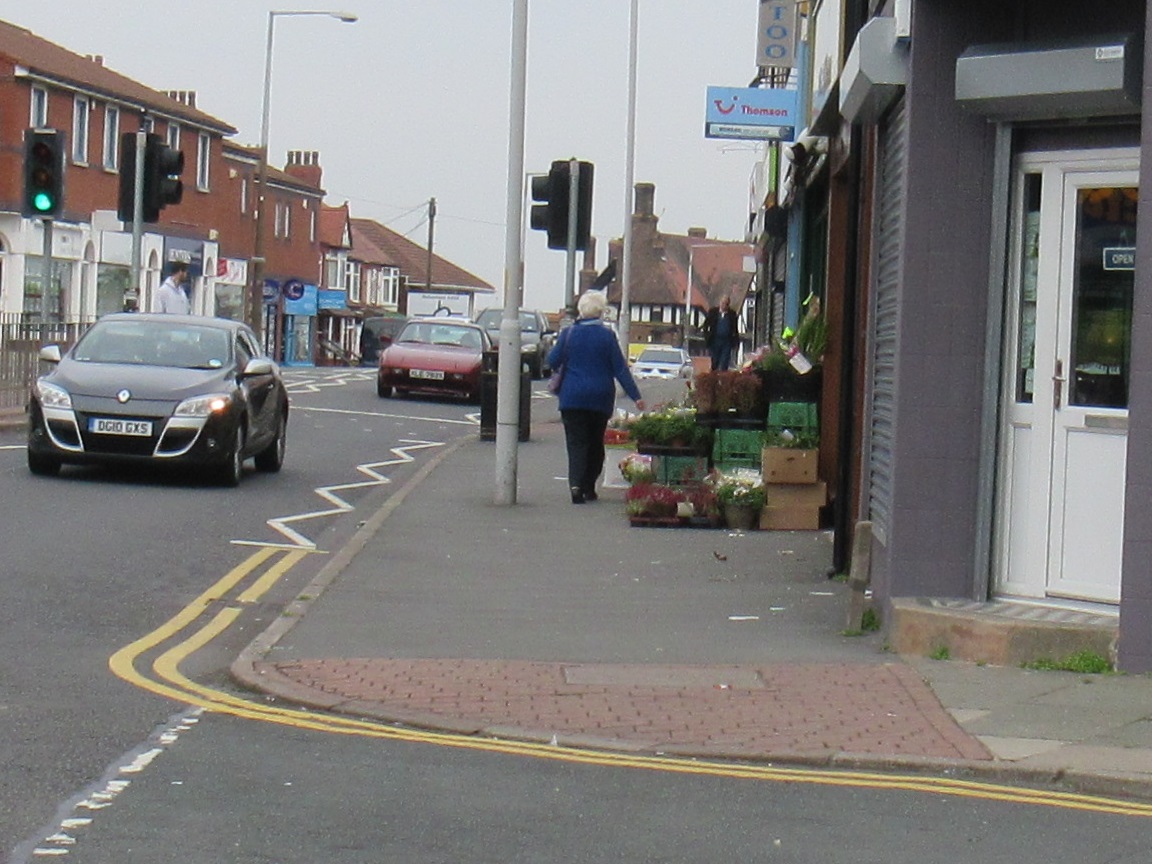 |
Wirral Council Officers have refused to take action, and furthermore, Mark Smith has written to the resident threatening him with legal action [32].
3. 'A' boards in West Kirby
Several 'A' boards in West Kirby were reported to Wirral Council as being in breach of the guidance through being positioned in the middle of the footway rather than adjacent to the business premises. The following response was typical "Inspection complete - no obstruction found wide footway", and the 'A' boards continue (at November 2015) to pose a hazard to visually impaired residents.
9. Conclusions
1. Wirral Council has obligations to protect vulnerable pedestrians, particularly children, those with visual impairment, and those with restricted mobility and other disabilities.2. Wirral Council has received many requests for help from and on behalf of these vulnerable people.
3. The responses from Wirral Council have been poor or very poor: actions that should have been obvious have not been taken and vulnerable people have suffered distress or been put at risk.
4. These failures constitute a failure of child protection and a failure to protect other vulnerable people. The current performance falls a long way short of commitments given in the Wirral Council Plan: A 2020 Vision [7], particularly the commitment
5. No progress has been made towards making "sustainable travel the option of choice" (the Vision of the Third Local Transport Plan for Merseyside [9]) - if anything conditions for walking have got worse.
6. Major changes are needed.
10. Relevant Background Information
Klonowski Report
Wirral Council's care of vulnerable residents was heavily criticised in the Klonowski Report of 2011 [33].Local Government Chronicle award of "Most improved council"
In 2015, Wirral Council was given the award of "Most Improved Council" by the Local Government Chronicle [7].11. Individuals Responsible within Wirral Council
Councillors
- Cllr Phil Davies (Leader of Wirral Council)
- Cllr Stuart Whittingham (Cabinet Member, Wirral Council)
Officers
- Eric Robinson (Chief Executive, from spring 2015)
- Kevin Adderley (Strategic Director for Regeneration and Environment, until autumn 2015)
- Mark Smith (Head of Environment and Regulation)
- Dr Fiona Johnstone (Director of Public Health)
12. References
| [1] | The Universal Declaration of Human Rights (1948) Proclamation by the General Assembly of the United Nations http://www.un.org/en/documents/udhr/ - see also a discussion of articles relevant to pedestrians at http://www.pedestriansafety.org.uk/human_rights.html |
| [2] | European Convention on Human Rights (1950, and later for additional protocols) http://www.echr.coe.int/Documents/Convention_ENG.pdf - or download from here |
| [3] | 1988 Road Traffic Act, Section 39 http://www.legislation.gov.uk/ukpga/1988/52/section/39 |
| [4] | Disability discrimination Equality and Human Rights Commission http://www.equalityhumanrights.com/your-rights/equal-rights/disability-discrimination |
| [5] | Equality impact assessment quick-start guide (2010) Equality and Human Rights Commission http://www.equalityhumanrights.com/sites/default/files/documents/PSD/equality_impact_assessment_guidance_quick-start_guide.pdf - or download from here |
| [6] | Metropolitan Borough of Wirral (updated 2014) Constitution of the Council http://democracy.wirral.gov.uk/documents/s50022281/CONSTITUTIONOFTHECOUNCIL2014amendmentsfromCouncilOctober2014.docx.pdf - or download from here |
| [7] | Wirral Council (June 2015) Wirral Council Plan: A 2020 Vision http://www.wirral.gov.uk/sites/default/files/all/About%20the%20council/Wirral%20Council%20Plan%20-%20a%202020%20Vision.pdf - or download from here |
| [8] | Wirral Council (October 2015) The Wirral Plan: A 2020 Vision; Delivery Plan - Phase One http://democracy.wirral.gov.uk/documents/s50028707/Delivery%20Plan%20Phase%20One%20Appendix.pdf - or download from here |
| [9] | Merseyside Integrated Transport Authority (2011) The third Local Transport Plan for Merseyside http://www.merseytravel.gov.uk/Site%20Documents/Full%20LTP3%20%28lo%20res%29.pdf - or download from here |
| [10] | Local authorities ranked by pedestrian casualties http://www.pedestriansafety.org.uk/casualties_by_local_authority.html |
| [11] | Wirral Council page on Travel Independent website http://www.travelindependent.org.uk/area_035.html |
| [12] | http://www.travelindependent.org.uk/confidence_intervals.html |
| [13] | Shock at road death statistics Wirral News October 8, 2008. |
| [14] | Road Safety Strategy: Consultation Version (July 2015) Birmingham City Council http://www.birmingham.gov.uk/roadsafetystrategy - or download from here. |
| [15] | Ofsted (2008) Annual performance assessment of services for children and young people in Wirral Metropolitan Borough Council 2008 download from here. |
| [16] | Road Safety - Reducing Death and Serious Injury on the Roads Report of the Director of Technical Services for Wirral Council's Sustainable Communities Overview & Scrutiny Committee - 17 November 2010 http://democracy.wirral.gov.uk/documents/s16366/Report.pdf - or download from here |
| [17] | Reports for Wirral Council meeting of 6 July 2015 http://democracy.wirral.gov.uk/documents/g5132/Public%20reports%20pack%2006th-Jul-2015%2018.15%20Council.pdf?T=10 - or download from here. |
| [18] | Street Audit - Dawstone Road, Gayton, Wirral (22 September 2014) Wirral Pedestrians Association http://www.wirralpedestrians.org.uk/files/street_audit_dawstone_road.doc - or download from here. |
| [19] | Pedestrian safety: A road safety manual for decision-makers and practitioners World Health Organisation (2013) http://www.who.int/roadsafety/en/ - or download from here |
| [20] | A Safe System Approach to Road Safety in Bristol: A Ten Year Plan 2015-2024 Bristol City Council (2015) http://www.bristol.gov.uk/page/transport-and-streets/road-safety - or download from here. |
| [21] | Feet First: Improving Pedestrian Safety in London (2014) London Assembly Transport Committee http://london.gov.uk/mayor-assembly/london-assembly/publications/feet-first-improving-pedestrian-safety-in-london - or download from here. |
| [22] | Annual Progress Report 2013/14: A New Mobility Culture for Merseyside (2014) Merseyside Transport Partnership http://www.letstravelwise.org/files/1614958673_2013-14%20LTP%20APR-FINAL.pdf - or download from here |
| [23] | Merseyside Adult Pedestrians Thematic Group Action Plan (2014) https://www.whatdotheyknow.com/request/232807/response/579267/attach/5/Thematic Group Action Plan.docx - or download from here |
| [24] | Unintentional injuries on the road: interventions for under 15s (2010, and reviewed with no change needed, 2014) National Institue for Health and Care Excellence http://www.nice.org.uk/guidance/ph31 - or download from here |
| [25] | L Deacon, C Perkins and M Bellis (2011) Road traffic collisions and casualties in the north west of England http://www.nwpho.org.uk/rtcs_nw/reports/RoadtrafficcollisionsandcasualtiesintheNW.pdf - or download from here |
| [26] | http://www.bristol.gov.uk/page/transport-and-streets/parking-restrictions (viewed 4 November 2015) The text is: "Footway parking ban
|
| [27] | Wirral Council's Guidance Note including Rules and Conditions for A Boards, Shop Displays and any other items displayed on the Highway (Version 2.1 Feb 2011). Download from here. |
| [28] | Review of Existing Policy/procedure Leq08 in Respect of Obstructions on the Highway and Licensing of A Boards, Shop Displays and Other Items (24 November 2014) Wirral Council Report https://www.whatdotheyknow.com/request/council_policy_on_a_boards_shop#outgoing-413941 - or download from here |
| [29] | Minutes of the Joint Wirral Council Pedestrian and Cycle Forum, of 16th December 2014 Download from here. |
| [30] | 'A' boards and shop displays Information on Wirral Council's website (viewed 26 October 2015) https://www.wirral.gov.uk/business/licenses-and-permits/roads-and-pavements/boards-and-shop-displays |
| [31] | Review of Existing Policy/procedure Leq08 in Respect of Obstructions on the Highway and Licensing of A Boards, Shop Displays and Other Items (24 November 2014) Wirral Council Report: Equality Impact Assessment https://www.whatdotheyknow.com/request/council_policy_on_a_boards_shop#outgoing-413941 - or download from here. |
| [32] | Letter from Mark Smith to Moreton resident, 10 July 2015. Download from here. |
| [33] | Anna Klonowski (Jan 2012) Independent review of Wirral Metropolitan Borough Councils response to claims made by Mr Martin Morton (and others): Final report https://www.whatdotheyknow.com/request/klonowski_report - or download from here |
